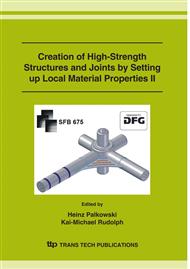p.191
p.219
p.247
p.295
p.317
p.347
p.375
p.413
p.451
Acoustic Measurements to Proof High-Strength Structures and Joints
Abstract:
Due to increased product requirements, usual conditions for materials cannot be applied anymore. To reduce energy consumption, lightweight constructions are demanded but they cannot stand necessary mechanical stress. Therefore, local reinforced elements are applied for instance. According to actual research in material sciences, it is prerequisite to verify the position of this strengthening. Various physical principles can be used for non-destructive testing of this effect. In this article, an approach based on acoustic signals is presented. On the one hand a strategy could be to do comparative studies between nominal and sample and on the other to predetermine the place just by acoustic parameters like eigenmodes. In preliminary test, vibration characteristics of these innovative materials (e.g. bake-hardening plate and sandwich structure) are determined and reveal capabilities for acoustic methodologies. So, this approach could be a promising tool to localize reinforced elements.
Info:
Periodical:
Pages:
451-456
Citation:
Online since:
October 2010
Authors:
Permissions:
Share:
Citation:


